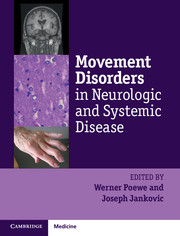Book contents
- Frontmatter
- Contents
- List of contributors
- List of videos
- List of abbreviations
- Preface
- Section I General principles
- Section II Movement disorders in systemic disease
- Chapter 4 Paraneoplastic movement disorders
- Chapter 5 Movement disorders of autoimmune origin
- Chapter 6 Movement disorders in systemic infections
- Chapter 7 Movement disorders in HIV- and AIDS-related central nervous system infections
- Chapter 8 Movement disorders in metabolic diseases in adulthood
- Chapter 9 Movement disorders in childhood metabolic diseases
- Chapter 10 Movement disorders in endocrinological diseases
- Chapter 11 Movement disorders in liver disease
- Chapter 12 Movement disorders in renal diseases
- Chapter 13 Movement disorders in hematological disease
- Section III Iatrogenic and toxic movement disorders
- Section IV Movement disorders in general neurology
- Section V Systemic complications of movement disorders
- Index
- Plate Section
- References
Chapter 4 - Paraneoplastic movement disorders
from Section II - Movement disorders in systemic disease
Published online by Cambridge University Press: 05 April 2014
- Frontmatter
- Contents
- List of contributors
- List of videos
- List of abbreviations
- Preface
- Section I General principles
- Section II Movement disorders in systemic disease
- Chapter 4 Paraneoplastic movement disorders
- Chapter 5 Movement disorders of autoimmune origin
- Chapter 6 Movement disorders in systemic infections
- Chapter 7 Movement disorders in HIV- and AIDS-related central nervous system infections
- Chapter 8 Movement disorders in metabolic diseases in adulthood
- Chapter 9 Movement disorders in childhood metabolic diseases
- Chapter 10 Movement disorders in endocrinological diseases
- Chapter 11 Movement disorders in liver disease
- Chapter 12 Movement disorders in renal diseases
- Chapter 13 Movement disorders in hematological disease
- Section III Iatrogenic and toxic movement disorders
- Section IV Movement disorders in general neurology
- Section V Systemic complications of movement disorders
- Index
- Plate Section
- References
Summary
Introduction
Paraneoplastic neurological syndromes are rare disorders of the central or peripheral nervous system that predominantly occur in patients with cancer, but cannot be ascribed to a direct invasion of the nervous system by the tumor, metastases, or side effects of oncological therapy. They are often associated with immune responses that cross-react with proteins expressed by both by the underlying tumor and neuronal tissue.
Paraneoplastic disorders frequently precede the cancer diagnosis. In these cases, features that suggest a movement disorder is possibly paraneoplastic include a recent, rapid or subacute, clinical onset, the presence of inflammatory changes in the CSF, and the identification of specific antineuronal antibodies in the serum or CSF (Titulaer et al. 2011). Once recognized, prompt identification and treatment of the tumor along with immunotherapy can result in neurological symptom improvement or stabilization.
For many years, the relevance of paraneoplastic etiologies in the field of movement disorders was considered to be low. Opsoclonus-myoclonus was one of the first syndromes recognized as a paraneoplastic movement disorder, but since opsoclonus is readily recognized by most physicians, specialists in movement disorders are rarely consulted for this syndrome. On the other hand, stiff person syndrome and its variants are well-characterized paraneoplastic syndromes in which specialists in movement disorders are frequently involved. Indeed, the differential diagnosis of this syndrome with other clinical disorders such as parkinsonism, rigidity, and dystonia has been an area of interest for clinicians in the last decade. This interest has increased recently with the discovery of a new category of paraneoplastic and autoimmune encephalitis associated with dyskinesias that are likely mediated by neuronal antibodies against cell surface and synaptic proteins. A substantial number of patients with these disorders develop behavioral and psychiatric disturbances in association with prominent motor abnormalities. Paraneoplastic chorea and atypical parkinsonism have also been reported in patients with antineuronal antibodies, and, in general, there have been many case reports in the last few years showing associations between cancer, movement disorders, and neuronal autoimmunity (Baizabal-Carvallo and Jankovic 2012). Different from the traditional approach of describing movement disorders in the context of specific paraneoplastic syndromes or antineuronal antibodies, this chapter reviews the paraneoplastic etiologies following a classification based on the movement disorders (see Table 4.1).
- Type
- Chapter
- Information
- Movement Disorders in Neurologic and Systemic Disease , pp. 39 - 51Publisher: Cambridge University PressPrint publication year: 2014

